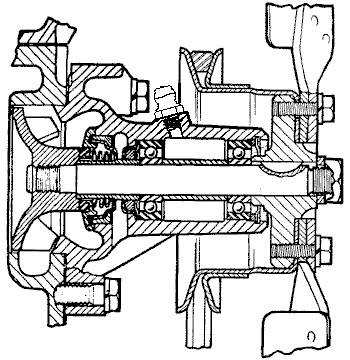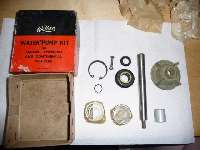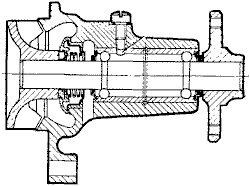The MGA With An Attitude
Water Pump LUBRICATION, Leaks and Failure - CO-108B
On 10/29/2011, Dave Barco in Baltimore, MD, USA wrote:
"Discovered a coolant leak, seeping from what looked like the base of the water pump. Do you have any encouraging advice, or should I belly up a take it to a professional"?
Most likely the fluid is coming out of a weep hole in the bottom center of the pump housing. If the internal fluid seal leaks, the fluid is supposed to drain out the bottom before it gets to the vicinity of the greased bearings. The weep hole is in the bottom of the casting between the water seal and the rear grease seal. On the outside this is on the bottom just ahead of the bolt flange. Most likely water comes out of this hole, meaning it has a leaky internal seal.
If this is a new water pump, you may have an easy fix. General instruction with a new pump is to run it dry for 30 seconds to a minute before installing coolant. This is to buff in and seat the new graphite seal against the smooth face of the impeller. I don't know why the water pump factory or water pump rebuilding shop does not spin these things in before shipping, but apparently they don't. In most cases it doesn't make any difference, because the seal can spin in and seat and seal on first start even with fluid in the system. But if it still leaks after a few minutes of running, you likely have to have the water pump rebuilt (again) or replaced.

Illustration at right is the early model water pump with two bearings with a shaft spacer in between. Photo below is a rebuild kit for this unit. The kit has been excessively rare and hard to find in recent years.

In the case of a used water pump, when it leaks it will almost never recover and needs to be rebuilt or replaced. Ordinarily the seal (once working) seems to last a very long time. I have seen water pumps where the bearings are worn so the shaft and fan blade can wiggle noticeably, and it still runs fairly quiet and does not leak. In fact I have seen cases where the fan blade will wiggle 1/16" at the tips, sometimes as much as 1/8" at the tips, and the thing keeps on working for many years to follow. When the bearings or impeller start making lots of noise, the end is near, and it should be changed immediately, as such severe misalignment will ultimately make the seal fail. In such cases you usually have an audible warning before the seal fails.

Later model water pump with
one-piece cartridge bearing.
|
On the flip side, sometimes the seal will fail before the bearings. In this case the failure is usually gradual, beginning with just a little fluid leaking out from the weep hole for an extended period of time. If you check radiator fluid and top it up occasionally you might get away with this for a long time without repair. Eventually the fluid leak increases and requires more frequent refilling. Do not ever let it run low on fluid and overheat the engine. Frequent refilling calls for immediate repair of the water pump. When it leaks a lot the fluid may get into the bearings to cause failure of the bearings.
Most water pumps prior to about 1960 had a grease fitting on top, or a flip-top oiler. For the flip-top oiler you could add a few drops of oil any time you like, usually when you changed engine oil. No problem if you overfilled it, just a little oil spill. For the grease fitting, normal instruction is one shot of grease every 12,000 miles. To me even that seems excessive, as it would means 8 shots of grease in 100,000 miles, in which case you might eventually end up blowing out the grease seals. If you get grease into the cavity aft of the bearings it can interfere with or even upset the fluid seal, ultimately causing failure of the fluid seal. So I would say if you bought a used car with unknown history, give it two shots of grease, followed by one or two shots every 50,000 miles.
This minimal greasing requirement is the cause of deletion of the grease fitting around 1960 or so. Water pump failure is minimal (nearly nil) in the first 50,000 miles if it is not greased, but may be a failure problem if it is over greased. During the transition period between grease fitting or not, some water pumps had a threaded plug fitted in place of the grease fitting. Most water pumps, new or replacement, for the past 50 years have no grease fitting on top, and no provision to install one. This is called "Lubricated for life", which means the life is limited to term of endurance of the initial grease filling. Instead of greasing it on rare occasion for half a million miles, you replace the pump when it fails at perhaps 100,000 mile intervals.
|